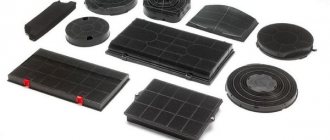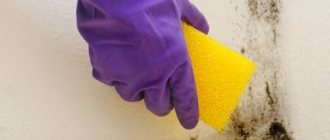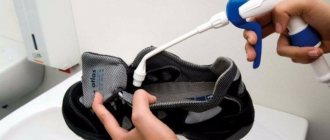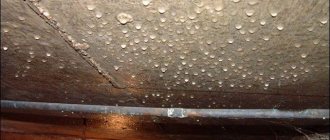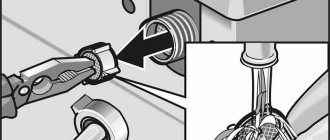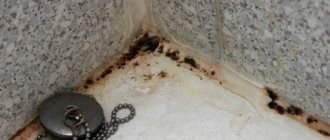The microclimate created in a bathhouse (sauna, steam room) is a confluence of favorable factors for the development and spread of various strains of mold. The reasons for the appearance of mold are increased humidity levels, high air temperatures, low-quality building materials, poor ventilation, and lack of sunlight.
If the steam room structure is wooden, then the spores penetrate deep into the wood and it is much more difficult to get rid of it if measures to remove it are not taken in a timely manner.
Mold in the bathhouse can provoke partial or complete destruction of the wood, which means that the steam room will have to undergo a major overhaul to replace individual logs.
Causes of mold in the bathhouse
There are two types of mold that can grow in a damp room: white and black.
Black mold grows on wood very quickly and, without prompt intervention, can lead to the replacement of the entire interior covering, and in the worst case, to damage to the load-bearing supports of the building. White mold produces incredibly toxic spores that can harm your health and cause a number of chronic diseases. Mold on a carriage in a bathhouse can form due to:
- Use of wood infected with fungus.
- Failure to comply with the layering of steam and waterproofing in the bathhouse.
- Disturbances in the ventilation system.
- Freezing of the structure and not regularly heating the bathhouse during the cold period.
Causes of mold in the bathhouse
Trying to simply remove mold without eliminating the causes of its occurrence is pointless. You need to deal with the causes, not the consequences.
Main reasons:
- Lack of a normal ventilation system or its poor performance. In a sealed room, high humidity can be maintained constantly, even if you open the door after visiting the bathhouse: the air simply will not circulate normally. This happens if ventilation is not done at all, or done incorrectly, or done, but over time it becomes clogged or damaged.
- Lack of windows, and as a result, lack of sunlight (mold thrives in rooms where there is little ultraviolet radiation).
- Excessive constant humidity is one of the main factors in the development of mold infestation.
- The frame of the bathhouse is made of wood, or its interior decoration is made of wood. Spores love wooden surfaces and quickly grow on them. And removing fungus from a tree is the most difficult thing. It often happens that mold eats into the wood so much that the finish only has to be replaced.
- Absence or incorrectly performed insulation, or insulation only from the inside. If there is no insulation at all, or it is not thick enough, condensation will accumulate on the inner surface in winter (and in humid conditions there will be a lot of condensation). If insulation is done only from the inside, the dew point may shift, and condensation will appear between the insulation and the wood (that is, it will not be visible from the room).
- Lack of external waterproofing.
What is the danger?
If the bathhouse or its interior decoration is made of wood, the appearance of mold will lead to disaster. The affected wooden structures will begin to rot, and very quickly. They may become unusable within 2-3 years from the moment of infection.
A serious problem is the impact of mold on people who will visit the steam room. Mold spores lead to the development of a number of allergic diseases, including bronchial asthma.
They can also lead to autoimmune diseases, including diseases affecting blood vessels and the heart. Transfer of infection is possible - spores can land on the clothes of visitors and be carried into their homes.
Where exactly does mold appear most often?
Most often, mold appears in the steam room itself, because it is constantly warm and humid (the conditions are simply ideal for fungus). But often outbreaks appear in other places, including the dressing room and rest room. This happens when there is no or poor ventilation in these rooms, and they are not ventilated after bath procedures. The reason is the water that visitors leave in the waiting room and rest room. If these rooms are not ventilated, the humidity inside them will increase.
Wooden buildings or rooms with wooden interiors are most susceptible to infection. You need to look for fungus first of all in the corners and on the walls, especially at the corners where the walls join.
Somewhat less often, lesions are localized on the floor, and even less often they are on the ceiling, usually after other areas have been affected.
How to deal with a fungal colony
Mold most often appears in wooden baths, which are heated not constantly, but from time to time. Fungal colonies have no special preferences. They settle on walls, floors, ceilings, where there is the most dampness . If the room is not insulated enough, a white mushroom appears on the tree (see photo).
You can fight a fungal colony:
- mechanically,
- chemicals,
- folk remedies.
Mechanical way of fighting
The method involves manually rubbing the affected area using a spatula, iron brush, or sandpaper. You can use a grinder or drill equipped with a brush attachment.
When performing mechanical cleaning, you need to look at how deep the fungus has penetrated into the soft texture. You can make a replacement. To do this, you need to cut out the affected area in the timber and insert a new fragment in its place.
Before cleaning the boards, the base must be thoroughly watered. Humidity will prevent the spread of pests.
Disposal during operation
If the room is not constantly heated, this is a favorable environment for the formation of fungus. The greatest importance should be given to wooden buildings, since they are in the main risk group.
Mold can appear on any surface in a room with high humidity. The fungus multiplies on the floor, ceiling or walls, as well as in corners. If the steam room is poorly insulated, mold will form there very soon. When the first symptoms of a fungus are detected, it is necessary to immediately begin its removal. There are three known ways to get rid of fungus in a bathhouse:
- Folk remedies.
- Mechanical. Cleaning the surface with a brush or sander.
- Store-bought drugs.
Folk methods or store-bought remedies mean treating contaminated material with aggressive substances.
In a bathhouse, the floor is often contaminated with fungus. In this case, it is advisable to remove boards with mold and remove some of the soil. She may also be infected. Boards with fungus must be replaced immediately. Treat the rest with antiseptic agents.
To avoid similar problems in the future, the bathhouse must be heated daily and well ventilated after its intended use. If mold appears in the bathhouse, you need to know how to get rid of it. You can use a store-bought product designed to kill fungus.
Checking and treating ventilation
Before you begin treating the ceiling, walls, corners and floors, you must carefully inspect the ventilation system. The first step is to open the shutters and inspect the ventilation duct. Some owners of baths and saunas effectively eliminate the source of mold by installing a fan near the grilles.
The ventilation system itself can be treated with a special primer. It is necessary to choose a product designed to work with wooden surfaces
But at the same time adhere to the dosage and take precautions so as not to burn the skin
Antiseptics
Special professional preparations will help get rid of fungus quickly and for a long time. It is advisable to choose products from well-known manufacturers, such as Biotop, Ceresit, Metas-Bio, Dali, Neomid-Bio. When purchasing chemicals from unknown companies, there may be no effect, but the money will be wasted.
The cost of the funds varies depending on the manufacturer. Special chemical compounds must be used carefully. Some are strongly absorbed into the wood, and then, as the ceiling, floor and walls heat up, they begin to release toxins into the air that are harmful to health. It is necessary to buy a ready-made deep penetration composition intended specifically for treating the ceiling, floor and walls of baths and saunas.
Mechanical stripping
If the fungus has not penetrated very deeply, you can try to clean the affected surface. The work is not very difficult.
For this you will need:
- Emery.
- Putty knife.
- Sander.
- Metal brush.
After removing mold mechanically, it is best to incinerate the waste. Thanks to this, the development of mold on other objects will be prevented. Mechanical cleaning is used when the fungus penetrates deeply. Part of the log is cut out and new material is inserted there.
Traditional methods
Fungus in a bathhouse can be destroyed using folk methods. They are effective and do not take much time.
To combat mold use:
- Bleach, consisting of water and quicklime. The solution is applied to the prepared dry surface.
- Copper sulfate, which can be purchased at gardening stores. To obtain a solution, you need to take 50 grams of vitriol, 30 grams of table salt and 100 grams of potassium alum per 1 liter of water. Before treating the walls with the product, you need to dry the surface, make a solution according to the instructions, and apply it to the walls with a brush. Repeat the procedure after two weeks.
- Seru. This method is cheap and effective. It is necessary to set fire to a sulfur bomb in a basin or bucket. When burned, it releases gases, effectively eliminating fungal spores.
- Hydrogen peroxide 25%. You need to carefully apply it to the wood and leave it. After a few hours, wipe the surface with a damp cloth.
- Whiteness. It is sold in any store at an inexpensive price. Apply the product to the walls, then treat them with water.
- You can coat the surfaces of the logs with 70% acetic acid. But this solves the problem only temporarily. The ventilation system needs to be repaired.
Mechanical removal of mold deposits
Cleaning the room from fungus begins with the lower tier of the bathhouse; if the first crowns have suspiciously darkened and changed color, then first of all you will need to get rid of the baseboard, floorboards and joists. Usually, in a situation where the fungus has climbed onto the lower part of the bathhouse wall, and even hard drying does not get rid of the dark gray coating, the floor needs to be dismantled and re-laid.
One of the reasons why fungus can get into the bathhouse is considered to be ineffective waterproofing paired with laid mineral wool slabs or expanded clay backfill. In this case, you need to get rid of all the floor elements, as in the video
Along with the rotted and fungus-ridden wood, part of the soil under the bathhouse is removed; as a rule, this procedure allows you to get rid of fungal spores that have grown on the inside of the concrete foundation strip. At the same time, the condition of the concrete waterproofing is checked. Sometimes mold grows on brick and concrete if warm moisture or condensation flows onto the foundation.
In this case, the tape is cleaned of traces of fungus and treated with concentrated solutions of chromium and iron salts. Getting rid of mold on brick and concrete is quite difficult, so you have to combine several drugs. Such treatment of the base of the bathhouse does not pose a particular danger to people, since it will be covered with insulation, and even helps get rid of rodents and woodworms.
The lower tier of the bathhouse is cleaned from the inside with an electric grinder; inaccessible places are cleaned with a hand grater and sandpaper. You need to try to get rid of all mold deposits without resorting to wetting the surface of the walls of the bathhouse.
If the bathhouse box is made of rounded logs, then you will need to remove all the jute or cotton insulation stuffed into the cracks between the crowns. In this case, it is advisable to lift the log in order to remove old flax at the joints and process the supporting planes.
After mechanical cleaning, the surface affected by the fungus is swept with a dry broom to remove wood dust, and chemical treatment of the walls of the bathhouse begins.
How to get rid of fungus in a bathhouse?
To destroy mold and prevent its reappearance on logs, treatment with special means alone will not help. This may temporarily remove plaque, but if the microclimate of the room does not change, the fungus will appear again.
It is necessary to radically change the conditions for using the premises and caring for them:
- The room should not be allowed to remain constantly damp and humid.
- You need to maximize air circulation. It is advisable to use forced ventilation (supply units, hoods) - it will allow you to renew the air as quickly as possible.
- Ideally, you need to provide access to sunlight into the room. This item is not mandatory; it is much more important to ensure ventilation and prevent dampness. However, if there are at least small windows in the bathhouse (for light to enter), this will be useful.
You need to fight the fungus as soon as you notice that black or white mold has appeared on surfaces.
Now about what to do if you notice mold in your bathhouse:
- If the bathhouse is damp, bring all the fans and heaters into it to warm it up, dry it out and ensure maximum air circulation. If the ventilation system was thought out during construction (there is at least a supply valve in the wall through which air will flow), the task is greatly simplified.
- While the room is being ventilated and dried, carefully examine all internal surfaces. Especially carefully inspect the corners of the floor and ceiling, joints (between boards), areas around windows and doors, areas that are covered by furniture, areas that are not exposed to sunlight.
- If the fungal infection is barely noticeable, you can immediately treat the surface with special means. If the lesions are large and the plaque is tangible, it must be cleaned off with a spatula and a metal brush. If mold has become embedded in finishing materials, it is best to dismantle them: even after treatment, spores may remain inside.
- Now select a product (from the list below) and apply it to the cleaned areas. You need to treat not only the affected area - cover at least 30-50 centimeters around it.
- Let the product work (how long it takes depends on what exactly you used for the treatment).
- Then we clean off the plaque again with a metal brush, wash the areas well and dry the entire room again.
In case of severe damage, the actions from points 4 and 5 must be repeated.
How to treat mold in a bathhouse: list of products
Removing fungus is a labor-intensive task, but it is doable. Both traditional and modern methods can help with this.
Effective drugs for destroying mold colonies are:
- vinegar for mold;
- copper sulfate;
- whiteness from mold;
- bleaching powder;
- sulfur;
- hydrogen peroxide for mold.
If you prefer more modern means, or if the affected area is very large, go to a hardware store. There you can choose a surface or deep treatment product designed specifically for mold removal.
List of tools that can be used:
- Senezha;
- Biotol;
- Dufa (based on chlorine);
- Ceresit;
- Metas-Bio;
- Neomid-Bio;
- ALFA-Fongifluid;
- Olympus-Stop.
You can choose other special equipment - not all names are listed above.
Eliminating the causes of mold in the bathhouse: prevention
The fight against fungus is not only about one-time destruction of the source of infection. Preventing the appearance of fungus is an equally important step.
Fungus in the corner at the joints of logs
To eliminate the causes of mold, you must:
- Ensure adequate ventilation in the bathhouse. To do this, you need to install a supply wall valve or window valve in each room. It will allow you not to lose the tightness while staying in the bathhouse, while it will be possible to properly ventilate it after each visit.
- If possible, it is worth making at least a small window in the steam room. In this case, it will not be necessary to install a supply valve for it.
- Periodically treat with an antiseptic, preferably in several layers, the places where the fungus develops most actively. If mold has not appeared anywhere before, then for prevention you can treat the corners and joints.
- Ventilate the bathhouse regularly. After each visit, all rooms, including the steam room, must be ventilated and dried dry. Leave doors and windows wide open; if there are any, turn on the exhaust and supply units.
- External wall insulation and waterproofing will also help in the fight against this malicious pest. This can be done both at the construction stage and if the building has already been built.
By following all the rules for maintaining and caring for a bathhouse, it will be possible to prevent the appearance of mold.
Preventive measures
Preventing mold from growing is easier than fighting mold that has already appeared. To do this, follow a few simple rules:
- after each use of the bathhouse at any time of the year, all rooms should be ventilated;
- if the building is equipped with fresh air ventilation, it is turned on at full capacity;
- open all windows and doors in the steam room, and, if necessary, install and turn on heaters to dry the premises;
- All places where there is a high probability of fungus appearing should be periodically soaked with antiseptics: copper sulfate, bleach, or a special product;
- carry out disinfection;
- periodically check the condition of the ventilation and immediately repair any damage;
- the steam room, the shower room, and the dressing room must be washed periodically;
- Do not leave wet towels, rugs, or brooms in the bathhouse.
All devices and items are dried and only then sent for storage.
Preventative work at the stage of laying a bathhouse and its construction
The most effective way to get rid of mold is to prevent its occurrence at the construction or even design stage. Preventive measures include the following:
- drawing up a competent ventilation project is the key to the absence of mold, as well as mustiness, dampness and destruction;
- installation of forced ventilation to ensure good ventilation;
- arrange vents - openings for natural ventilation and vents;
- install ventilation valves in the windows, if any;
- for construction, choose logs cut down already during frosts: they are most resistant to temperature changes;
- Treat boards, lining, any wooden parts with antiseptic solutions before installation;
- use only high-quality waterproofing; you cannot skimp on it: insufficient protection of walls from moisture significantly reduces the service life of the steam room.
Important! Mistakes during the construction of a bathhouse result not only in the appearance of mold, but also in heat loss, high heating costs, and destruction of finishes, walls and floors.
Danger to humans
All types of mold pose a danger to humans. The products of their metabolism are strong poisons that cause poisoning. Mold spores pose a serious risk of respiratory illness. Indoors, they are always in the air and easily enter the body through breathing. They are a strong allergen and a person exposes himself to the risk of developing a chronic runny nose, cough and conjunctivitis. The general condition of a person worsens.
If the immune system is too weak to resist infection, then vital organs are affected: the lungs, esophagus, stomach and liver. Further development of disorders leads to serious illnesses ranging from rhinitis, pharyngitis, bronchitis and reaching pneumonia, cerebral edema, damage to the nervous system and the appearance of cancer cells. Mold is often the cause of bronchial asthma.
Once on the skin, hair and nails, the fungus causes various tissue damage. With prolonged interaction with mold, problems with the musculoskeletal system appear. The kidneys, liver, and other important organs of the human body are at risk.
Where does mold most often appear in a bathhouse?
Molds hide well and you will have to work hard to detect them in time. Obvious mold appears only when the colonies are already quite developed and spread to the walls, ceiling, and floor of the bathhouse.
If an unpleasant, persistent smell of dampness appears in the sauna, then you should think about the presence of hidden mold spores. You can find it in hidden, hard-to-reach places:
- at the joints of logs;
- in the corners;
- along the edge of shower trays;
- in water drains;
- on bath shelves;
- in ventilation pipes.
As a rule, fungus appears in places that, due to difficult access, often remain insufficiently cleaned and washed. Each kindling and visit to the bathhouse should be completed with a thorough cleaning of the room using various detergents that contain anti-mold substances.
Sources of mold: damp rugs, towels that remain on the floor or benches after turning off the heating of the bathhouse. Screens in the interior of the bath should be straightened so that moisture does not accumulate in the folds.
If mold appears in the bathhouse, how to get rid of it? There are plenty of effective remedies aimed at combating fungus. Some of them are developments of the chemical industry, others are passed down from generation to generation and are folk methods of combating the spread of various types of fungal colonies in the bathhouse.
Prevention
The main factor for mold growth is moisture. In houses, saunas and apartments there are many places for fungus with good conditions for active reproduction. He lives in wood, drywall, between slabs.
Prevention measures:
- Fungus develops in the bathhouse due to steam. Unfortunately, steam cannot be avoided; this is a sauna after all. But you can treat walls and floors with special compounds once a month if the bathhouse is at home and once a week if it is a public place. A good way to prevent condensation from occurring is to install insulation.
- Always check faucets, pipes and roof for leaks.
- Indoor humidity can be reduced by opening doors and windows to dry the walls after each use of the sauna. Air conditioners will also help reduce indoor humidity levels.
- One common cause is wet towels left on a sauna bench. You cannot leave them in the sauna; after that you need to hang them outside.
Such measures will reduce moisture in the room and, accordingly, prevent the growth of fungus.
Uneven battle: fungus in the bathhouse, how to get rid of it
After several unsuccessful attempts, people continue to puzzle over how to eliminate fungus in the bathhouse. Indeed, often the state is close to panic: after all, you wouldn’t burn a bathhouse with napalm to scrape off the mold?
We hasten to reassure you, currently the chemical industry offers a lot of effective means, but if you are a supporter of antiseptics close to natural ones, then the advice of experienced people will help you out here.
Proven remedies: how to remove fungus in a bath
Bacteria with spores have the ability not only to grow in breadth, but also in depth, penetrating between logs. The confrontation is further complicated by the fact that mold is not immediately visible on the surface, so it is not only the infected areas that need to be treated, but the entire space.
It is worth taking into account that remedies for fungus on wood in a bathhouse, both chemical and natural, can affect not only malicious pests, but also the person himself
Remember, do not neglect the following precautions:
Remember, do not neglect the following precautions:
- Before starting treatment, put on thick clothing, gloves, a hat, goggles and a bandage or mask that protects your respiratory tract. Such equipment is never superfluous.
- After carrying out sanitary procedures, do not leave the door locked. Allow the room to be well ventilated.
- When the product has taken effect and is no longer needed, thoroughly wash all surfaces with plenty of water.
Let's move on directly to how to remove fungus from a tree in a bathhouse.
The most common weapon is a special anti-mold primer. When purchasing it, consult with the seller and make sure that the substance is suitable for your purposes. After all, mold can stick to both tiles and metal. You need a composition that is safe for wood. Carefully read the instructions on the back, which will indicate: the amount of primer required to treat the surfaces, as well as the duration of exposure.
Photo from the site https://banyabest.ru
Cleaning the sauna against fungus: disinfection
Since wood is an organic, natural material, it is in active contact with microorganisms. Mold can penetrate into the top layers of the boards. Therefore, the best solution for removing fungus on boards in a bathhouse is, of course, the mechanical method. It represents grinding when the surface is polished.
You can also remove build-up with an automatically rotating brush with coarse bristles. Before you start scraping off the fungus, you need to generously moisten the affected area with water to avoid harmful dust. If the situation is so serious that this particular elimination method is required, it is better to contact a specialist who, if necessary, can cut out the damaged part and replace it.
But in case of timely detection, chemical compositions are quite effective
It is important to note that in most cases they are absorbed into the walls and later, when the air temperature increases, they can release toxic fumes. Therefore, you need to choose this composition very carefully.
There are currently three categories of processing agents:
- oil-based antiseptics, they are considered organic;
- water-based products;
- combined antifungal compounds.
A fungus has appeared in the bathhouse, but you don’t know how to destroy it? Feel free to choose water-based antiseptics. Of all those presented, they are considered the safest, since they weather easily and do not penetrate into the structure of the tree itself. Again, carefully read the product label directions before use.
List of basic recommendations
- To build a bathhouse, try to use wood cut in winter. In the fall you can lay the foundation, and in the spring you can install a bathhouse;
- Check the wood carefully. If you find characteristic signs, even if there is a healthy one nearby, do not take it. She is already affected and the appearance of spots is a matter of time;
We invite you to read Finishing a stove with tiles with your own hands │ How to stick tiles on a stove with your own hands
If it is possible to use a moisture meter when choosing, great.
- Be sure to provide “vents” for natural ventilation of the underground, attic and in the ribs of the frame;
- Properly arrange the waterproofing of the foundation and supporting structures (this also applies to vapor barriers);
- Provide effective exhaust ventilation;
- Treat the surfaces of the bathhouse with an antiseptic;
- Insulate freezing external walls, slopes and ceilings;
- If double-glazed windows are installed in the bathhouse windows, insert ventilation valves (for ventilation).
- Promptly repair leaking plumbing fixtures and communications;
- Check the cleanliness of the ventilation ducts and the functionality of forced ventilation;
- If the bathhouse has the possibility of constant heating, provide it sufficiently;
- Try not to leave wet fabrics (towels, sheets, etc.) in an unheated bathhouse (for example, in a country house), and always straighten plastic shower screens (curtains) for complete drying;
Mold absolutely loves dirt. Therefore, wash the bathhouse regularly and thoroughly. Regular rinsing with water is not entirely effective. There are special household hygiene products for baths and saunas on sale. For example, Finnish cleaning solution HARVIA Sauna, Tolu and others. They are applied with a soft sponge and washed off with warm water.
Even before construction it is worth considering:
It is better to use wood cut down in winter as a material for constructing a bathhouse.
In the autumn, it is better to limit yourself to laying the foundation, and with the arrival of spring, build the bathhouse itself. Pay special attention to wood quality control. Try not to take even healthy wood if it grows next to a defective tree
We can assume that it is also infected, and it is only a matter of time before it becomes stained and begins to deteriorate.
It is better if you have a moisture meter at hand - it will greatly simplify the process of choosing the right tree.
When building a bathhouse, remember:
- Be sure to equip the underground, attic and frame ribs with ventilation.
- Lay high-quality vapor and moisture insulation on the foundation and supporting structures.
- Consider and install an effective ventilation system.
- Treat all surfaces in bath rooms with an antiseptic substance.
- Insulate slopes, ceilings and external walls to prevent freezing.
- If the bathhouse has double-glazed windows, then it is worth installing valves for ventilation.
During operation, do not forget about these recommendations:
- Try to repair damaged plumbing and communications in a timely manner.
- Clean the ventilation ducts in a timely manner and also check the functionality of the forced ventilation.
- If it is possible to carry out constant heating, this will have a positive effect on the bathhouse, since it will prevent the appearance of mold, and the structure will last longer.
- Do not leave any damp fabrics in an unheated bath; always allow them to dry completely.
Conclusion
A clean, ventilated room is the key to good rest
Of course, when deciding how to remove mold, you first need to think about the fact that it is easier to prevent its appearance than to remove it after it appears. Simply rinsing will not remove dirt, so you need to wash the sauna regularly and thoroughly. In addition, periodically treat with preventative agents.
Our portal is ready to provide additional information on this issue, which is also contained in the proposed photos and videos in this article.
Did you like the article? Subscribe to our Yandex.Zen channel
Why is fungus dangerous?
Mold spores are not dangerous as long as they are inactive. They are activated due to dampness: condensation and stagnant moisture. Molds produce mycotoxins that cause various diseases. A healthy body will not react immediately to the harm of mold, but later problems will definitely appear. For a person with a weakened immune system, mold can serve as a catalyst for exacerbation of diseases.
We invite you to familiarize yourself with a chimney in a bathhouse with your own hands: how to do it correctly: features of the device and step-by-step recommendations for assembly in photos and videos
Spores enter the body through the air and through the skin. They cause the following ailments:
- allergy;
- respiratory diseases (bronchitis, pneumonia, asthma);
- skin problems - dermatitis and eczema.
Reasons for the appearance of fungus in the bathhouse
Fungus in bathhouses indicates that you should first pay attention to the ventilation system. The fact is that warm and humid air creates optimal conditions for microscopic fungus to begin to develop
And if you do not react in time, then within a short period of time the spores will have time to penetrate the walls a few centimeters, after which it will be very difficult to remove them.
Even at the initial stage this is not an easy task.
Recommendations for combating fungal infections
- Only high-quality bath ventilation will help prevent fungus.
To prevent fungus, you need to take care of high-quality ventilation.
- We treat not just a place, but the entire room.
- We check the ventilation: clean all gaps, eliminate damage.
- Perhaps the easiest way to combat mold is to use a special primer.
- When purchasing a primer, you should make sure that it is not a preventative, but is intended to eliminate mold.
- Select compounds that are specifically designed for woodworking.
- During processing, all recommendations must be strictly followed, including dosage, safety precautions and processing time.
We treat the surface with a primer.
- There are many specialized products for combating mold in the bathhouse. And almost all of them are unsafe: some destroy wood, others can harm human health. And the price of most formulations is quite high.
Therefore, when processing wood with their own hands, many home craftsmen use folk remedies, which are cheaper and cause less harm.
Folk remedies
There are many folk remedies for how to fight fungus in a bathhouse.
Consider the most popular of them:
- Sulfur. Instructions for carrying out work:
- During processing, it is necessary to close the ventilation holes and plug all cracks.
- In a metal or ceramic vessel, light several pieces of sulfur at the rate of 200 grams of sulfur per 100 m3 of room.
- When burning sulfur, sulfur dioxide is released, which kills all fungi. Sulfur is also unsafe for human health, so as soon as it is set on fire, immediately leave the room and close the sauna door tightly.
Box with sulfur.
- 6-9 hours after the start of the procedure, bring a box of quicklime into the room. It will absorb the remaining sulfur dioxide and also dry out the room. Only then will you be able to use the treated room.
- First of all, we put on gloves and a respirator.
- Bleaching powder.
- We clean the walls from mold. A spatula can be used for this.
- Dissolve bleach in a small amount of water.
- The resulting solution should be used to treat the walls.
- Another option is to dilute bleach with formaldehyde. This method also allows you to effectively combat mold.
When choosing this method, you need to consider the following: bleach not only effectively kills fungus, but can also harm your walls. Therefore, the composition should be used very carefully.
Bleaching powder.
- Inkstone. It is a solution that is more gentle on wood and is excellent at killing mold. Prepare the solution as follows: mix 22 grams of iron sulfate, 18 grams of table salt, 44 grams of potassium alum. The dosage is given per liter of water. Using a roller, sprayer or brush, treat all surfaces with the resulting composition.
- There are several other recipes that are used to treat walls:
- 0.4 kg of boric acid, 1.4 liters of table vinegar, 0.9 kg of borax.
- 0.5 kg of copper sulfate and a liter of acetic acid.
The solutions are heated to a temperature of about 70 degrees Celsius, after which they are sprayed or brushed onto the damaged surfaces. Let the surfaces dry, and after a month we repeat the treatment.
Special spray equipment allows for faster surface treatment.
